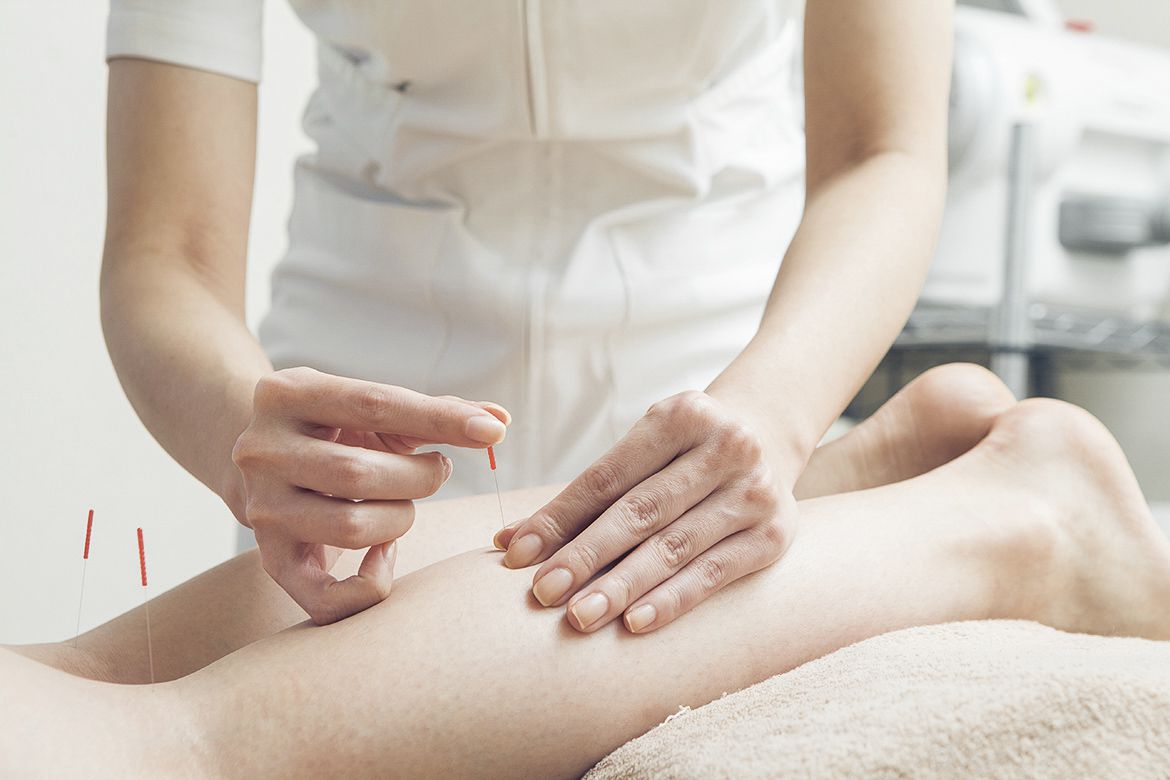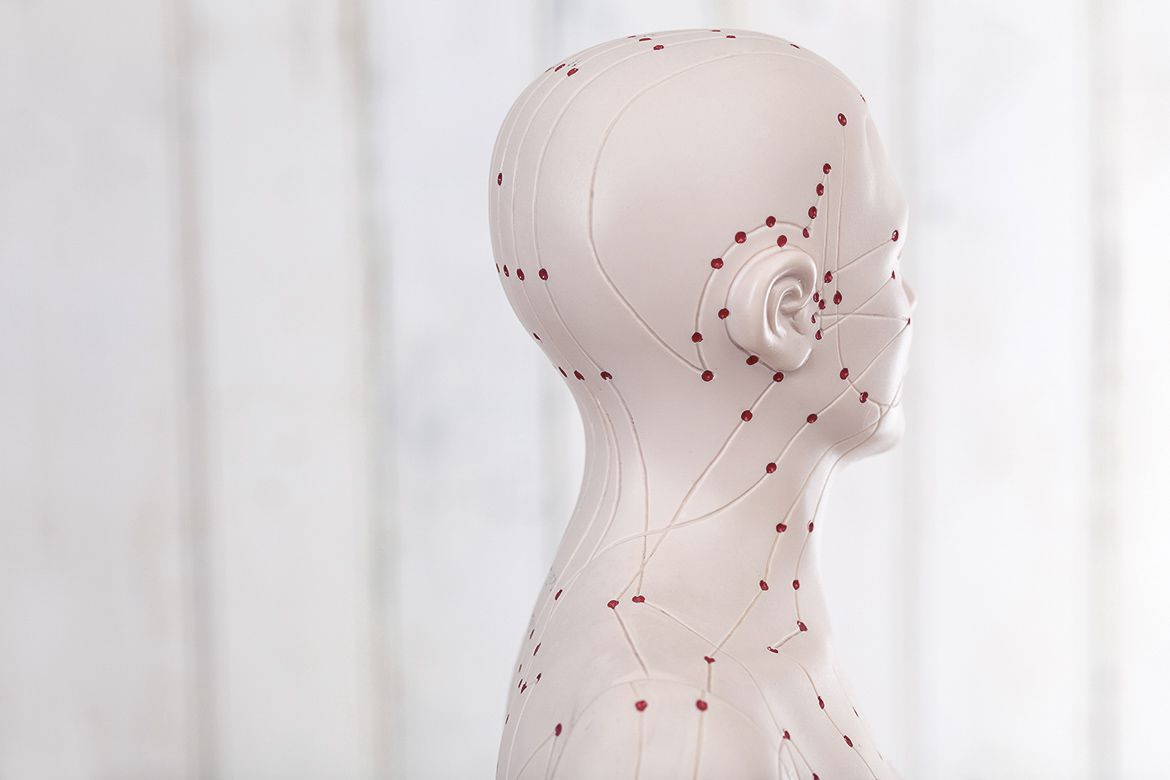.jpg)

.jpg)
.jpg)
.jpg)
Acupuncture
Introduction to Acupuncture
Acupuncture stimulates the balance and flow of Qi energy that in Traditional Chinese Medicine is considered essential to health. When the body is healthy, Qi flows smoothly through the meridians that make up a conceptual network of pathways throughout the entire body. When the balance or flow of Qi is deficient or obstructed it may be diseased or susceptible to illness. Acupuncture treats both the symptoms and the root causes of the patient’s illness.

According to Traditional Chinese Medicine theory, Qi circulates in the body through a system of channels called meridians. Qi can be stimulated in the body through various acupuncture points on the surface and flows to deeper organ structures. The stimulation of Qi in the meridians allows the body to rebalance from the negative impacts of daily life and diseases.
Because acupuncture therapy has unique advantages, it has a wide range of implications. Its curative effect is rapid and obvious, the procedure is straightforward, the medical expenses are economical, and there are few side effects. Acupuncture has been an important part of Chinese medicine for generations, and in today’s world, it has spread to more than 140 countries and regions around the world, playing an important role in upkeeping and maintaining the health of people around the world.

Acupuncture Needling Therapy
The most common acupuncture treatment method involves the insertion of thin needles into the specific acupuncture points in the skin tissue with a plastic guide tube. Needles may be manipulated in various ways, including spinning, flicking, moving up or down relative to the skin and insertion at different angles. The point of insertion is called an acupoint, and according to the latest acupuncture textbook statistic, the human body has a total 361 positive acupoints.
Plum Blossom Needle Therapy
Plum Blossom Needle therapy is an alternative acupuncture technique that uses an instrument with a flexible handle attached to a plastic head that has 5 to 7 small needles arranged in a circular pattern. The practitioner uses the instrument to gently tap on acupoints to help invigorate and smoothen blood and Qi circulation.
.jpg)
Modern Acupuncture techniques
Modern acupuncture and moxibustion techniques include scalp acupuncture, eye-acupuncture, hand acupuncture, foot acupuncture, wrist acupuncture, acupoint laser treatment, acupoint embedding treatment, acupoint magnetic therapy, acupoint injection therapy, acupoint cutting treatment and acupoint ligation treatment.
Other Acupuncture techniques
Triangular acupuncture, skin acupuncture, intradermal acupuncture, fire acupuncture, electroacupuncture, and warm acupuncture.
Advantages of Acupuncture Therapy
Acupuncture is a unique form of medicine that aids in the recovery of many different types of health issues. In clinical practices, the practitioner will diagnose cause of the disease or illness, after which the practitioner will prescribe the most effective form of acupuncture therapy. The unique advantage of acupuncture therapy is that it is does not rely on taking any medications for treatment. In addition, there are many other advantages of acupuncture therapy:
Acupuncture can be used to treat a wide range of illnesses ranging from internal to external, and from infants to the elderly. Acupuncture is also used as a preventative and facilitative treatment method.
The results of acupuncture are quick and significant. These results are exemplified in cases such as disease resistance, analgesia and pain relief.
The procedure of acupuncture is straight forward and simple.
The medical expenses associated with acupuncture therapy are quite low compared to other alternative forms of medical treatment.
Acupuncture therapy is safe and reliable and there are few adverse or side effects involved with acupuncture therapy. In addition, acupuncture therapy can be combined with other therapies for an affective and comprehensive treatment plan.
Applications of Acupuncture Therapy
The scientific and cultural knowledge of acupuncture and moxibustion in the natural and social environment of China has always been a significant part of Traditional Chinese medicine. Acupuncture therapy is comprised of many practical observations, knowledge of human anatomy, and technical skills. Acupuncture therapy will remain as an important part of the Chinese nation and will continue to maintain and facilitate the health of people from all around the world. Acupuncture therapy has a wide range of adaptations. Many diseases ranging from internal, external, infant, elderly, female, skin specific, and trauma can be treated with acupuncture. The World Health Organization (WHO) also publicly announced 44 conditions which are effectively treated with acupuncture.
These diseases are as listed:
Respiratory Diseases
1. Allergic rhinitis 2. Sinusitis 3. Rhinitis 4. Cold 5. Tonsillitis 6. Acute and chronic laryngitis 7. Tracheitis 8. Bronchial Asthma
.jpg)
.jpg)
.jpg)
Gastrointestinal diseases
15. Esophagus, cardia achalasia 16. Hiccup 17. Gastroptosis 18. Acute and chronic gastritis 19. Hyperacidity 20. Chronic duodenal ulcer (pain relief) 21. Simple duodenal ulcer inflammation 22. Acute and chronic colitis 23. Acute (chronic) bacillary dysentery 24. Constipation 25. Diarrhea 26. Intestinal paralysis

Neurological, muscular and skeletal diseases
27. Headache 28. Migraine 29. Trigeminal neuralgia 30. Facial nerve paralysis 31. Mild sputum after stroke 32. Peripheral neurological disorders 33. Pediatric polio sequelae 34. Meniere’s syndrome 35. Neurogenic bladder dysfunction 36. Enuresis 37. Intercostal neuralgia 38. Cervical arm syndrome 39. Shoulder coagulation 40. Tennis elbow 41. Sciatica 42. Low back pain 43. Arthritis 44. Cerebral palsy.
Other applications of Acupuncture Therapy
Learn more

Weight Loss and Weight Management
Through stimulation of specific acupoints around the hypothalamic-pituitary-adrenal cortex and the adrenal medulla, the body’s base metabolic rate can be increased to help promote weight loss and fat reduction. In addition, acupuncture stimulation helps to strengthen the function of the kidney and the spleen. There are several benefits to using acupuncture for weight loss:
Firstly, Weight loss through acupuncture can effectively regulate the metabolic process of lipids. Patients who are overweight may have a higher concentration of lipid peroxide. After using acupunctural and moxibustion procedures, the lipid peroxide concentration in the body will be reduced. This causes the body to increase its metabolic function to help churn fat and achieve weight loss.
Secondly, Acupuncture procedures can help the patients facilitate and correct irregular appetites through regulation of the nervous system. The procedures can inhibit excessive secretion of gastric acid and help the patient to feel less fatigued and hungry.
Finally, acupuncture procedures are effective at managing endocrine disorders. Cases of endocrine disorders are usually high for patients who are overweight or obese. Endocrine disorders are also common among women who are going through menopause and post-pregnancy. Typically, women gain weight during these periods of time as their bodies have a more difficult time managing their endocrine systems. Acupuncture will help the body to regulate the hypothalamic cortex and the adrenal cortex, both systems are responsible in correcting endocrine disorders and speeding up the body’s metabolism.
There are many ways to lose weight, however, acupuncture weight loss is convenient, straightforward and risk-free. Weight loss drugs usually have adverse effects on the body after a period of use. However, acupuncture procedures take a completely different approach. These procedures typically strengthen your body’s own metabolic functions to induce weight loss in a more natural process.
.jpg)
Health care
Chinese people have used acupuncture procedures to protect and strengthen their bodies since ancient times. Acupuncture healthcare and acupuncture treatment are very similar but with a different focus. Acupuncture treatment focuses on correcting the body’s yin and yang balance and to stimulate Qi and blood stagnation. However, Acupuncture healthcare focuses on strengthening the internal functions of the body to improve metabolism and functions of internal organs. The aim is to promote healthy living and to increase longevity. The different focuses are reflected in the acupuncture method. For treatment procedures, many acupoints are targeted compared to fewer target acupoints in healthcare-focused procedures.
.jpg)
Beauty
Acupuncture beauty is based on the overall concept of traditional Chinese medicine. Acupuncture is used to stimulate the skin to smoothen the skin and to beautify the face. Skin diseases and issues can be treated with local stimulation. When blood flow is stimulated and increased, toxins and unnecessary oils are flushed out to promote clearer and smoother skin tones. Sometimes, moxibustion will be used in addition to local acupuncture to aid with treatment. This procedure is simple, easy to use, non-toxic, harmless, and shows substantial results in a rapid time frame.
Learn more
.jpg)